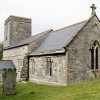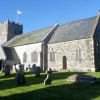A large, pretty village of greensand, brick and timber-framed dwellings between high chalk downland, could fairly describe Fontmell Magna in a nutshell. To this we could add that it is quite above the average among those Dorset parishes less fortunate in that they straddle a relatively busy arterial road, in Fontmell’s case the Blandford-Shaftesbury stretch of the A350.
The name Fontmell translates as “the stream by the bare hill”, referring to the streams which flow through the surrounding meadows at the foot of the downs. But like most villages Fontmell has a long history of settlement, beginning at least as early as the Bronze Age, a time represented by two round barrows marking the resting-places of Wessex Culture chieftains. Its history in writing however begins in the 8th century, where it appears for the first time in an early Saxon charter recording that Coinred, father of King Ina, granted a deed of land in the area of the parish. Coinred does not however refer too the serfs, presumably of Romano-British stock, who must have worked this land.
Domesday Book then takes up the chronicle when in 1086, it records that among the holdings there were four mills. Such a number of mills would have needed quite a few millers to work them, and infers that as early as the late 11th century this village must have a (relatively) populous and well-developed community.
With the exception of the lower courses of its tower, the original medieval church of St. Andrew was entirely rebuilt in 1862. The parapet is copied from an original 16th century section of parapet, now on display in the north aisle. Standing in the churchyard is a memorial to Lt. Philip Salkeld, son of a former rector, acknowledging an act of outstanding military valour. During the Siege of Delhi in the Indian Mutiny of 1857, Salkeld, in the company of five other comrades, led the detail appointed to lay the explosive to blow up the Cashmere Gate on September 14th. This operation made the capture of Delhi possible, but it cost Salkeld his life after his arm was shattered by gunfire. A Sapper called Burgess then tried to light the fuse, but he too was killed, and it fell to a man called South to complete the task. Apart from the bugler, South was the only member of the party to survive. The Salkeld memorial commemorates his award of the VC – one of fewer than five Dorsetmen to earn it.
A former mill on the east side of the high street is now a residence with an attractive new façade. The mill pond, which once worked the wheel, is fed by a clear stream issuing from springs at the base of the chalk. Just a few hundred yards from its source this stream supplied the necessary clean water for the brewery on the west side of the street, for generations an industrial mainstay of the village’s economy.
It was in the adjoining house that the author, publisher and former head of Cassells, Sir Newman Flower, was born in July 1879, the eldest son of Fontmell’s brewer. In his autobiographical ‘Just as it Happened,’ Sir Newman relates some timely anecdotes presenting an interesting insight into the harsh, often uncouth day-to-day life in Fontmell during his formative years. There is the day he is reported to his father by a water bailiff for shooting a trout in the stream, and the gamekeepers in the wood who were shot at; the friends he went to school with, who perished in the trenches.
The village to the west of the main road is characteristically something of a warren of sinuous back lanes beyond the range of traffic noise. Fontmell has a post office, shop, and a neat row of cottages along the A350 facing the Crown Inn and a large brick mill behind. The cottages are thatched, probably of the 17th and 18th century, but some Victorian houses are also present nearby. A little beyond the village is the 17th century Manor Farm, typical architectural features of the period: mullioned windows with four lights (panes) and hood moulds, with stone and black-tarred barns attached. Woodbridge Mill, one-and-a-quarter miles north west, is early 19th century. One-and-a half miles to the east stands Fontmell Hill House, a grand residence built for the composer Balfour Gardiner. In 1843 Sir Richard Glyn provided Fontmell with a school, where one obligation of the girls was to sew shirts for their benefactor.
One interesting historical record of Fontmell is the village Clothing Book, a vellum-bound archive begun in 1861 by the tailoring Stainer family. The book records four generations of villagers formed a kind of savings cooperative to pay for clothing. The scheme was rather like an early form of Christmas Club and an informative insight into Fontmell’s social history.
Another is an archive kept between 1934 and 1949 by Rolf Gardiner at Springhead Farm. Long before green politics began to assert itself, Gardiner was a committed practitioner of sustainability, one of the earliest ecologists to promote organic farming. In 2003 his son, Sir Eliot Gardiner commissioned a survey of Gore Farm Forest’s ecology and archaeology, a copy of which has been donated to the archive.
This survey was effectively the springboard for what is now known as the Fontmell Magna Project. This project is in partway (though not exclusively) a response to the decline in local farming, which is why the archive team are in the process of collecting items from local farmers, so as to reconstruct something of the history of their holdings. But the Fontmell Magna Project envisages a number of phases disseminated over the coming decade. As far as funding permits each phase concerns a particular aspect of heritage, or the assets of Fontmell parish. The project is already promoting a better understanding of these heritage assets. Furthermore it is being very much youth-led. Many young people are enthusiastically involved in building up a database and running a mobile exhibition.
Volunteers are meeting monthly to sort and catalogue the treasures, while children from St. Andrew’s School are participating in a survey of local trees, which culminated in an exhibition in June 2003.
We may wonder how these children of today, had they been that age 30 years ago, would have documented one particular tree, an elm, which once occupied a pivotal position in the life and folklore of the village. The Gossip Tree doubtless furnished much-welcome shade in tortuous high summers of old. But the summer of 1976 and the added complication of Dutch Elm disease attack, proved too much for its centenarian constitution. A lime sapling, complete with commemorative plaque was planted to replace the Gossip Elm sometime after.
Perhaps it is as well the embattled old elm died more or less from natural causes rather than from a woodman’s chain saw, for a curious legend soon attached to it, saying that misfortune would befall anyone involved in cutting it down. But Fontmell retains another indigenous, possibly older legend. Any native of the village, it is said, who leaves it is destined never to return to retire there if he or she is successful in life – only failures ever come back. This myth is only likely to exercise the interest of folklorists, though curiously, when Newman Flower retired he did not return to Fontmell, but made a new home for himself in Tarrant Keyneston.



